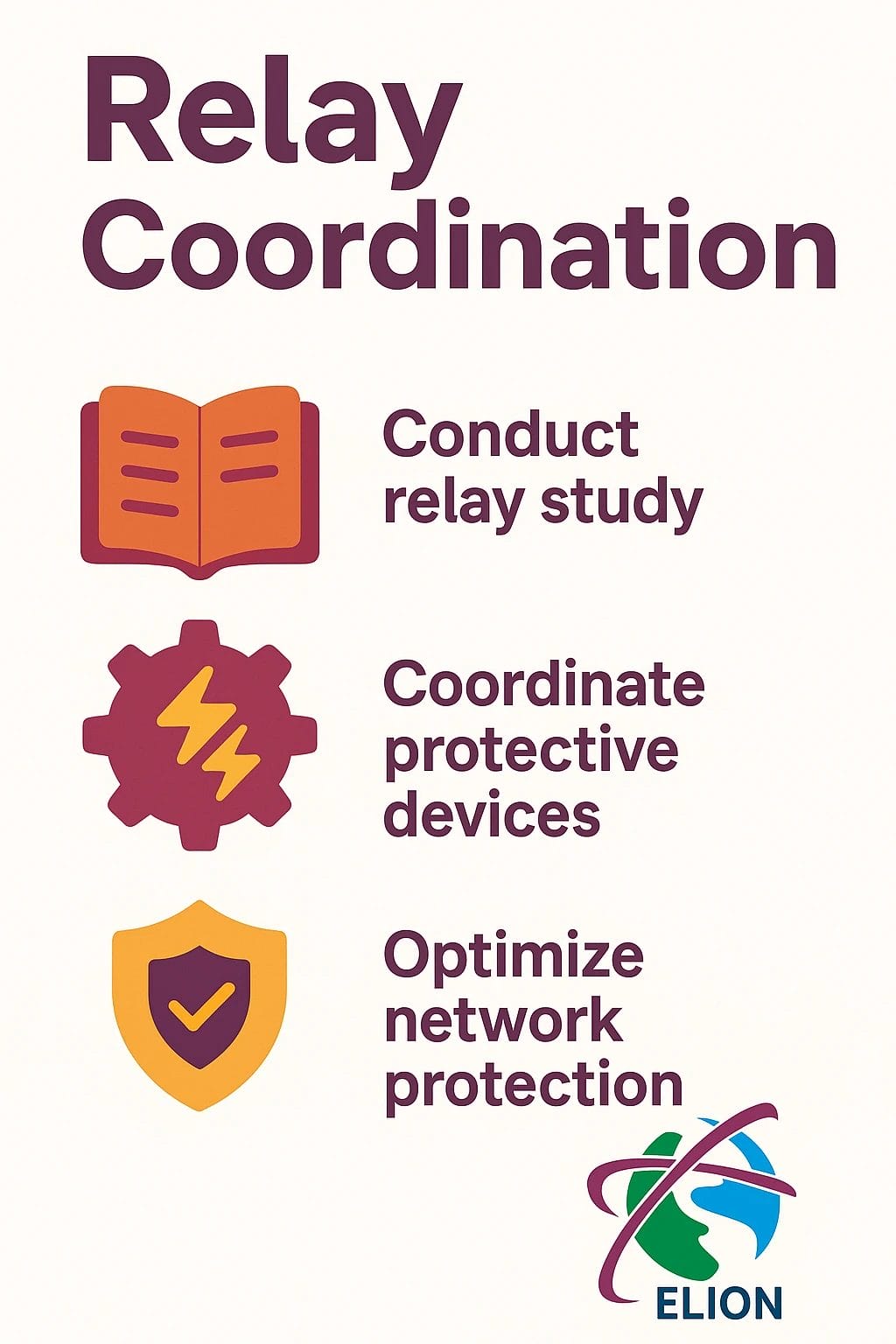Training Coordinator, Industrial Paint Manufacturer
“The safety induction for new hires was handled smoothly. Elion brought their own AV equipment and kept the session engaging. We’re thinking of repeating this monthly.”
Relay Coordination involves setting and coordinating protective relays in an electrical system to ensure selective isolation during faults, minimizing disruption while protecting equipment and personnel.
A well-executed Relay Coordination Study helps optimize relay settings so that only the faulty section is isolated during a fault, maintaining power continuity in the rest of the system.

Ensure the safety, reliability, and efficiency of your electrical system with Elion’s expert Relay Coordination Studies.
Request a Quote or contact us at [email protected].
“The safety induction for new hires was handled smoothly. Elion brought their own AV equipment and kept the session engaging. We’re thinking of repeating this monthly.”
“Good response from our team for the chemical spill drill and awareness session. We had a minor leak last year and this training was timely. They even explained the MSDS sheet details clearly.”
“Elion conducted ergonomics training for our office support staff. They gave tips that don’t need any budget—just posture, breaks, and seating angles. Everyone found it useful.”
“Warehouse safety training was organized at our distribution center. The module covered stacking, material flow, and emergency handling. One or two team leads found the content basic, but the newcomers appreciated it.”
“The hot work and gas cutting safety training helped us address some recent near-misses. Our fabrication contractors said it was the first time anyone explained why permits matter, not just how to fill them.”
“We held a training on ergonomics and workstation safety. Elion’s speaker had a practical approach—suggested small furniture changes and posture tips that didn’t cost much but helped our office staff.”
“Elion covered cold storage safety and ammonia handling well. Some of our technicians said it was the first time they understood how to respond to leaks. We may request them for a follow-up drill.”
“Our garment unit required machine safety awareness for new joiners. Elion kept it interactive and used visuals from our own plant, which the workers related to.”
“The crane and material handling training helped reduce near misses in our yard. The trainer also gave tips that were not in the slides, based on their field experience. That made a difference.”
“We requested a training module on emergency evacuation procedures. Elion included site-specific examples which helped. The mock drill later was well-coordinated too. Our fire wardens felt more confident after the session.”
Adjusting protective relays for selective tripping during faults.
To isolate only the faulted section while keeping the rest operational.
IS 3231, IEC 60255, IEEE 242, IEEE 399.
ETAP, PowerFactory, Dialux (for lighting coordination when relevant).
Graphs showing time-current behavior of relays for coordination visualization.
SLDs, equipment ratings, relay specs, fault data.
Calculation of fault levels to determine relay settings.
Yes, upon request.
Yes, by timely isolation during faults.
Every 3-5 years or after major system changes.
Fields marked with an asterisk (*) are required
An on-site emergency plan is a crucial component of any organization’s overall safety and risk management strategy. It is designed to ensure the safety and well-being of employees, visitors, and the public in the event of an emergency or disaster. By having a well-thought-out emergency plan in place, organizations can…
Process safety management (PSM) is a systematic approach to managing the hazards associated with processes involving highly hazardous chemicals. It is designed to prevent unwanted releases of hazardous chemicals, which can lead to fires, explosions, and toxic exposures. PSM is crucial for industries such as oil and gas, chemical manufacturing,…
Power transmission systems serve as the backbone of modern electrical infrastructure, enabling the efficient transfer of electricity from generation sources to end-users. These systems encompass a vast network of components, including transmission lines, substations, transformers, and distribution networks. As we delve into the intricacies of power transmission, we recognize that…
Road safety training is an essential aspect of ensuring the safety of all road users, including pedestrians, cyclists, and motorists. It is crucial to educate individuals on the importance of following traffic rules and regulations, understanding road signs, and practicing safe driving behaviors. By providing comprehensive road safety training, individuals…
Behavioral safety training is a proactive approach to workplace safety that focuses on changing employee behaviors to reduce the risk of accidents and injuries. This type of training is based on the idea that most workplace accidents are caused by unsafe behaviors rather than unsafe conditions, and that by addressing…
Safety record-keeping is an essential aspect of any organization, regardless of its size or industry. Maintaining accurate and up-to-date safety records is crucial for several reasons. Firstly, it helps to ensure the safety and well-being of employees and visitors to the workplace. By keeping detailed records of incidents, near misses,…
Elion, a leader in industrial safety training, has established a reputation for delivering comprehensive programs that address the unique challenges faced by various industries, particularly in high-risk environments such as refineries. The company recognizes that the nature of industrial work, especially in sectors dealing with hazardous materials and complex machinery,…
Chemical risk assessment is a crucial process that involves the evaluation of the potential adverse effects of chemical substances on human health and the environment. It is a systematic approach that aims to identify, characterize, and quantify the risks associated with exposure to chemicals, in order to make informed decisions…
As we embark on our journey together, we find ourselves at the heart of Team Elion, a dynamic group dedicated to excellence in our respective fields. Our team is not just a collection of individuals; we are a cohesive unit that thrives on collaboration, innovation, and a shared vision for…
Industrial safety training programs are essential for ensuring the well-being of employees and the success of a business. These programs provide employees with the knowledge and skills they need to identify and mitigate potential hazards in the workplace, ultimately reducing the risk of accidents and injuries. By investing in industrial…